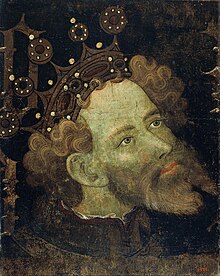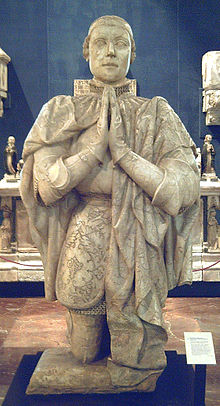| War of the Two Peters | |||||||
|---|---|---|---|---|---|---|---|
| Part of the Hundred Years' War | |||||||
| |||||||
| Belligerents | |||||||
|
With the support of: Kingdom of England Republic of Genoa Kingdom of Portugal Kingdom of Navarre Emirate of Granada |
With the support of: Henry II of Castile Kingdom of France | ||||||
| Commanders and leaders | |||||||
|
Peter of Castile Edward the Black Prince John of Gaunt |
Peter IV of Aragon Henry II of Castile | ||||||
| War of the Two Peters | |
|---|---|
| Hundred Years' War | |
|---|---|
The War of the Two Peters (Spanish: La Guerra de los Dos Pedros, Catalan: Guerra dels dos Peres) was fought from 1356 to 1375 between the crowns of Castile and Aragon. The conflict was a struggle between two claimants to the throne of Castile, Peter of Castile and Peter IV of Aragon. The former Peter was supported by England and several English nobles led by Edward III and his son, while the latter Peter was supported by France. The conflict also brought in the involvement of the kingdoms of Navarre and Portugal. The war resulted in Aragon gaining the upper hand, but it also devastated its economy that was already reeling from the effects of the Black Death.
Background


At the beginning of the fourteenth century, Castile was suffering from unrest caused by its civil war, which was fought between the local and allied forces of the reigning king, Peter of Castile, and his half-brother Henry of Trastámara over the right to the crown.
Peter IV of Aragon supported Henry of Trastámara. Henry was also supported by the French commander Bertrand du Guesclin and his "free companies" of troops. Peter of Castile was supported by the English. The War of the Two Peters can thus be considered an extension of the wider Hundred Years' War as well as the Castilian Civil War.
Peter of Castile sought to claim the Kingdom of Valencia, which included parts of Murcia, Elche, Alicante, and Orihuela. Peter of Aragon wished to dominate the Mediterranean in opposition to Castile and Castile's ally Genoa.
A naval incident between the two powers had already caused tension: Catalan galleys, armed by Mossèn Francesc de Perellós, who had letters of marque from the Aragonese king, aided France against England, and also managed to capture two Genoese ships at Sanlúcar de Barrameda. Genoa was an ally of Castile. Peter of Castile, leading the Castilian fleet, caught up to Perellós at Tavira but was unable to capture him.
War
1356–1363
The war lasted from 1356 to 1375, prolonged because Peter of Castile lost his throne to Henry of Trastámara. The war primarily took place on the border between Castile and Aragon, namely Aragonese border towns such as Teruel, which fell to the Castilians.
In 1357, Castile penetrated Aragon and conquered Tarazona on March 9; on May 8, they arranged a temporary truce.
At the beginning of 1361, the Castilians conquered the fortresses of Verdejo, Torrijos, Alhama, and other places. However, the peace of Terrer (sometimes called the peace of Deza) was negotiated on 18 May 1361, in which all conquered places and castles were returned to their original lords. Bernardo de Cabrera, ambassador of the Aragonese king, negotiated the peace. Peter IV married his daughter Constance to Frederick III the Simple.
In June 1362, Peter of Castile met with Charles II of Navarre at Soria, and mutual aid was promised. Peter also contracted an alliance with Edward III of England and Edward's son The Black Prince.
With these negotiations complete, the Castilian king invaded Aragonese territory without officially declaring war, and the conflict commenced again. The Aragonese king was at Perpignan without troops, and thus caught off guard. The Castilians took the castles of Arize, Atece, Terrer, Moros, Cetina, and Alhama. Peter of Castile was unable to take Calatayud, even though he attacked it with all types of siege machines. Without taking his conquests any further, he returned to Seville.
In 1363, Castile continued the war against Aragon, and again occupied Tarazona. Peter of Castile received reinforcements from Portugal and Navarre. Meanwhile, the Aragonese king negotiated a treaty with France and a secret treaty with Henry II of Castile. Pedro of Castile then conquered Cariñena, Teruel, Segorbe, Morvedre, Almenara, Xiva, and Bunyol.
The papal nuncio Jean de la Grange arranged the peace of Morvedre (Sagunt) (2 July 1363) between the two kings. The peace was not ratified, however, and hostilities continued. The Castilians penetrated the Kingdom of Valencia in 1363, and conquered Alicante, Caudete, Elda, Gandia, and other places.
1363–1369
From 1365 to 1369, Peter of Castile was preoccupied with maintaining his position on the Castilian throne against Henry of Trastámara.
The Castilian Civil War began in 1366 and Peter of Castile was dethroned. He was assailed by his illegitimate brother Henry of Trastámara at the head of a host of soldiers of fortune, including Bertrand du Guesclin and Hugh Calveley. Peter abandoned the kingdom without daring to give battle, after retreating several times (first from Burgos, then from Toledo, and finally from Seville) in the face of the oncoming armies. Peter fled with his treasury to Portugal, where he was coldly received by his uncle, King Peter I of Portugal, and thence to Galicia, in northern Spain, where he ordered the murder of Suero, the archbishop of Santiago, and the dean, Perálvarez. Both the Archbishop and the Dean were supporters of Henry.
Peter of Castile was overthrown in 1369. He was killed by Henry.
Invasion of Valencia
The Kingdom of Granada supported Peter of Castile in the War of the Two Peters. Castilian troops and their Moorish allies invaded southern Valencia, which suffered low-level ravaging and political instability. The Castilians unsuccessfully laid siege to Orihuela in 1364.
End of the war

Castile recovered comarcas that had passed under Aragonese rule, such as the lordship of Molina. A marriage was contracted between Eleanor of Aragon, daughter of Peter IV of Aragon, and John I of Castile, the successor of Henry II of Castile.
The misery of the war was compounded by the Black Death and other natural disasters, such as drought and a plague of locusts. These events ruined the Aragonese economy, leading to a decrease of the country’s population. The Cathedral of Tarazona was destroyed during the war and not rebuilt until much later.
However, the war is believed to have led to the establishment of administrative and military forces that would ultimately result in a unified Castile and Aragon in the next century.
References
- Archived June 9, 2007, at the Wayback Machine
- "1360 - 1365". Uv.es. Retrieved 2015-05-31.
- "Guerra de los dos Pedros (1356-1369) - Página de voz - Gran Enciclopedia Aragonesa OnLine". Enciclopedia-aragonesa.com. Retrieved 2015-05-31.
- "Villalon and Kagay - The Hundred Years War: A Wider Focus". Deremilitari.org. Retrieved 2015-05-31.
- "If these walls could talk". Thinkspain.com. Archived from the original on 2016-01-21. Retrieved 2015-05-31.
- Archived December 21, 2007, at the Wayback Machine
- Donald J. Kagay, "The Defense of the Crown of Aragon during the War of the Two Pedros (1356-1366)," The Journal of Military History, Volume 71, Number 1, January 2007, pp. 11-31.
Bibliography
- Kagay, Donald J. (2007). "The Defense of the Crown of Aragon during the War of the Two Pedros (1356–1366)". The Journal of Military History. 71 (1): 11–31. doi:10.1353/jmh.2007.0040. S2CID 201755047.
{{cite journal}}: CS1 maint: postscript (link) - Kagay, Donald J. (2012). "The War of the Two Pedros (1356–1366): Aragon's Successful Administrative Strategy of Asymmetrical Defense". Imago Temporis: Medium Aevum. 6: 191–222.
- Kagay, Donald J. (2013). "Disposable Alliances: Aragon and Castille during the War of the Two Pedros and Beyond". Studies in Medieval and Renaissance History. 10: 111–47.
{{cite journal}}: External link in|postscript= - Villalon, L. J. Andrew (2008). ""Cut Off Their Heads, or I'll Cut Off Yours": Castilian Strategy and Tactics in the War of the Two Pedros and the Supporting Evidence from Murcia". In L. J. Andrew Villalon; Donald J. Kagay (eds.). The Hundred Years War (Part II): Different Vistas. Leiden: Brill. pp. 153–84.
| Hundred Years' War | |||||
|---|---|---|---|---|---|
| Phases |
| ||||
| Leaders |
| ||||
| Major events |
| ||||
- 14th century in Aragon
- Wars involving the Crown of Aragon
- Wars involving Portugal
- Wars involving the Kingdom of Castile
- Conflicts of the Hundred Years' War
- History of the Valencian Community
- Military history of Catalonia
- 14th-century conflicts
- 14th century in Castile
- Wars of succession involving the states and peoples of Europe